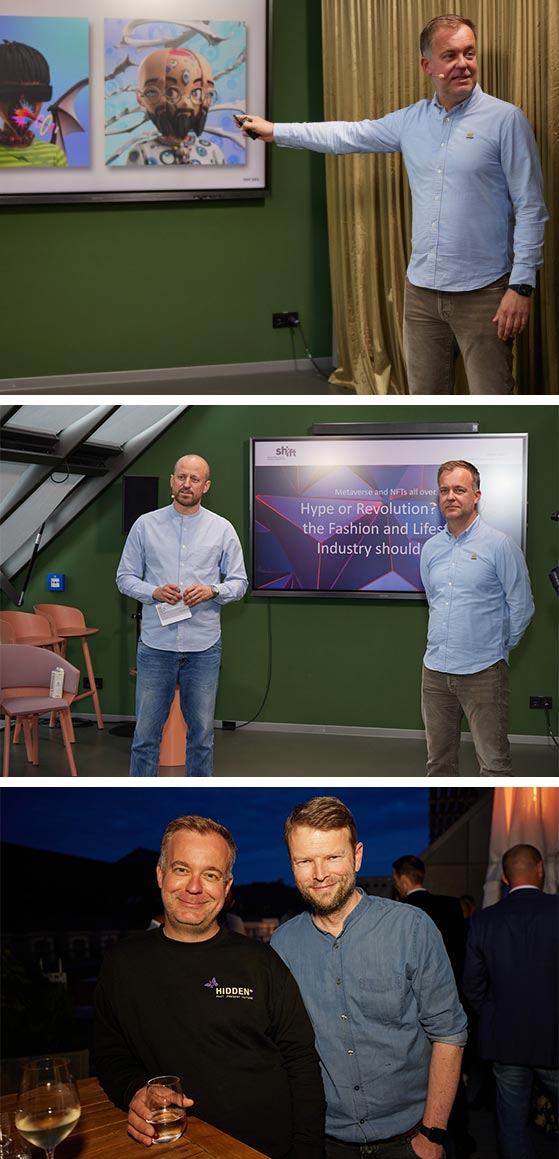Creative futurist Jürgen Alker advises exploring the phenomenon of Web3 before making the decision whether to engage with it. At SHIFT, he talked about one of the earliest NFT hero stories from the fashion industry, which ended up in millions of euros in profit––and opened our eyes to the new business models that are possible today.

For over a year, Jürgen Alker’s bedtime has shifted from ten or eleven o’clock to three or four in the morning. “You can spend endless amounts of time on it,” he enthused about his new passion. The shift to night owl is no problem for the founder of NFT studio Highsnobiety, who can look back on a classic if turbulent career.
So what’s a metaverse? To expand our mental horizons, Alker explained that it may not even be a virtual place. Perhaps it’s a point in time, albeit a highly abstract one: the moment when the Web becomes more important to an individual than the physical world. Given this, it could be fair to say that once Jürgen Alker spends more than twelve hours a day with the metaverse and NFTs, he has already reached that point.
So what’s an NFT? Alker explained that it could be seen as an entry in a register confirming that something belongs to somebody. Like a Land Register. Except there is no registry with a shelf of lever arch files containing the proof of ownership. That proof is now distributed among thousands of computers, and is therefore unfalsifiable. One of the major criticisms directed at the blockchain technology underlying NFTs is thus the enormous amount of energy it consumes.
While this problem still awaits a solution, a further prejudice was quickly––and, literally, playfully––dismantled by Alkerwith the story of RTFKT. The tech company is one reason why Alker is losing sleep. The virtual sneakers created by its three masterminds kicked off a wave of hype that not only earned them around 100 million dollars in the blink of an eye, but also enabled them to sell their company to Nike at the end of 2021 for a reported 500 million dollars. To achieve this, they needed well-respected artists to design shoes and avatars, plus good storytelling and good ideas––but hardly new ones: more along the lines of a treasure hunt or lottery seller. Early bird purchasers can sell on straight away, or hang fire. Anyone in at the start who had patience and a little luck is now a millionaire. It’s the kind of tale that gets attention.
The new business model functions for two main reasons. First, the creators at RTFKT understood that some products, such as fashion, can be covetable without the slightest semblance of practicality. “It’s about community, about status, about being different from your parents,” explained Alker. But if practicality is no longer a selling point, the product might just as well be virtual. According to Alker, many kids see the cryptocurrency used in Fortnite as being just as important as their physical pocket-money––and just as useful to them in their world. Perhaps that metaverse time mentioned earlier isn’t so far away after all.
The second reason why the model functions is that blockchain technology offers everyone the option of marketing their own art or products themselves.
“At the moment there are no creators uploading content to Insta and earning money from it,” noted Alker, pointing out that all the earnings are raked in by the platforms, which monetarize the content through advertising. Alker warned that an age may be dawning in which everyone earns what they deserve. The decentralized nature of Web3, combined with the idea of creaming off power from major platforms, makes the model appealing for many people
and also allows people to participate exactly where they want to: “Lady Gaga could sell a million NFTs for a dollar apiece and say, ‘Now you can watch my concert on my website,’” suggested Alker. It’s a completely new form of creating value. No middlemen. The only question is, when will we find time to sleep?
Watch video on YouTube:
https://www.youtube.com/watch?v=jLHM_JfgSNQ